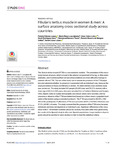Fibularis tertius muscle in women & men: A surface anatomy cross-sectional study across countries

Use this link to cite
http://hdl.handle.net/2183/29959Collections
- Investigación (FEP) [507]
Metadata
Show full item recordTitle
Fibularis tertius muscle in women & men: A surface anatomy cross-sectional study across countriesAuthor(s)
Date
2019-04Citation
Palomo-López P, Losa-Iglesias ME, Calvo-Lobo C, Rodríguez-Sanz D, Navarro-Flores E, Becerro-de-Bengoa-Vallejo R, et al. (2019) Fibularis tertius muscle in women & men: A surface anatomy cross-sectional study across countries. PLoS ONE 14(4): e0215118. https://doi.org/10.1371/journal.pone.0215118
Abstract
[Abstract] The fibularis tertius muscle (FTM) is a rare anatomic variation. The prevalence of this exclusively human structure, which is found in the anterior compartment of the leg, is often underestimated, and it is believed that foot and ankle conditions are more difficult to manage in patients with an FTM. The aim of this study was to assess the presence of the FTM palpation and determine whether its presence is associated with an individual’s sex, because the exact prevalence in males and females is unclear. An observational cross-sectional study was carried out. The study included 481 people (23.49% men and 76.51% women) with a mean age of 23.51±5.369 years, who were recruited from a Podiatric Medicine and Surgery Clinic (Spain). Data on routine demographic and clinical factors were recorded, and the presence or absence of the FTM was determined based on surface visual or palpated localization of the tendon (using a consistent protocol). The FTM was present in 38.25% (184/481) of the participants. Furthermore, FTM were present in 38.6% (142/481) of females and 37.2% (42/481) of males. The study revealed that the presence of the FTM varies between individuals and does not depend on an individual’s sex. Significant differences in the prevalence of the FTM between countries should be carefully evaluated rather than generalizing the results of this Spanish study to other non-Spanish populations. Larger numbers of participants should be enrolled in future studies in order to meet the statistical criteria.
Keywords
Muscle functions
Funciones musculares
Body weight
Peso corporal
Tendones
Tendons
Ankle
Tobillo
Foot
Pie
Funciones musculares
Body weight
Peso corporal
Tendones
Tendons
Ankle
Tobillo
Foot
Pie
Editor version
Rights
Atribución 3.0 España






